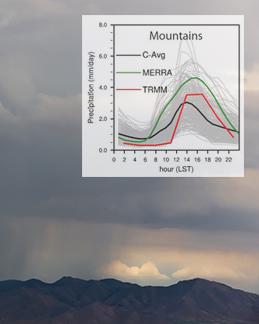Parametric Sensitivity and Uncertainty Quantification of Precipitation at Global and Local Scales in CAM5
When crunched, climate model numbers can fluctuate depending on which climate components are examined. To quantify this uncertainty, researchers at Pacific Northwest National Laboratory systematically identified six modeling parameters that have the greatest influence on modeling global precipitation. They found that the influence of individual parameters does not depend on sampling approach or the associated parameters.
By using Uncertainty Quantification (UQ) tools, they showed that the precipitation variance is caused by contributions from individual parameters most of the time. Further, the variation is seasonally influenced significantly in mid-latitude regions—not so much in tropical continental regions.
A research team led by PNNL used two model sampling approaches (the Latin hypercube sampling and quasi-Monte Carlo) to explore the high-dimensional (wide variance) parameter space and identify the most influential parameters. They conducted two large sets of simulations: 1100 simulations in the cloud ensemble focused on 22 parameters related to cloud and convection processes, and 256 simulations in the aerosol ensemble focused on 16 parameters related to aerosol and cloud microphysics. They also applied a surrogate model (generalized linear model) to provide quantitative measures of how sensitive the model output is to uncertain parameters.
"While this study only focused on the response and sensitivity of precipitation to model parameters, we demonstrated an approach that can be easily applied to other variables of interest," said Dr. Yun Qian, PNNL atmospheric modeler and lead author of the study.
This approach will guide the next step to reducing a model's precipitation uncertainty by calibrating the most uncertain parameters and developing new model parameterizations for those components.
The Earth's climate involves complex interactions among ever-changing physical components and chemical processes. There are myriad ways that clouds form and uncounted conditions that provoke precipitation. Climate researchers work to break down those processes and components into simpler representations so that computers can be used to understand how those processes interact. Usually, climate modelers "tune" these representations, called parameters, one at a time and then assume the response in the model is related to that individual parameter.
The researchers in this study found that precipitation does not always respond to individual parameter tuning in this way. Further, they found that certain parameters influence independently, rather than through interactions among them, to produce much of the precipitation variance in the models. These findings lead the researchers to investigate parameter tuning that considers each component's physics, without having to consider compensating errors from other parameters. Their work increases confidence in more targeted studies that focus on a single parameter and its effects on precipitation.
Prediction of future climate change remains both a high priority and a complex challenge for science. Insufficient physical understanding and relatively coarse grid resolution limit the ability of global circulation models (GCMs) in this endeavor. Despite increased computational power enabling higher resolution, GCMs still must rely on parameterizations (computational methods to simplify complex physical processes) to represent the subgrid variability of clouds, aerosols, and their interactions. An additional challenge is resolution dependency of these representations, resulting in inconsistency in modeling aerosols, clouds, and precipitation at different resolutions. In research led by Department of Energy scientists at Pacific Northwest National Laboratory, scientists investigated the sensitivity of precipitation characteristics (mean, extreme, and diurnal cycle) to dozens of uncertain parameters mainly related to cloud and aerosol processes in the Community Atmosphere Model (version 5). They found that extreme precipitation characteristics are sensitive to a fewer number of parameters; that precipitation does not always respond monotonically to parameter change; and that the influence of individual parameters does not depend on sampling approaches or related parameters selected. The study was a fast process investigation responding to parameter perturbation in the current climate, over a 5-year period with prescribed sea surface temperatures. The study better explains the CAM5 model behavior associated with parameter uncertainties and will guide the next step to reducing model uncertainty in precipitation via calibration of the most uncertain model parameters and/or developing new parameterizations.
We thank Charles Jackson for his careful review and constructive comments. This study was supported by the U.S. Department of Energy's Office of Science as part of the Earth System Modeling Program. The Pacific Northwest National Laboratory is operated for DOE by Battelle Memorial Institute under contract DE-AC05– 76RL01830. Work at LLNL was performed under the auspices of the U.S. Department of Energy by Lawrence Livermore National Laboratory under contract DE-AC52- 07NA27344. All C-Ensemble results are stored at LLNL supercomputer, and all A-Ensemble results are stored at a local PNNL cluster. To request copies of the data used in this study, please contact Yun Qian: yun.qia@pnnl.gov.

